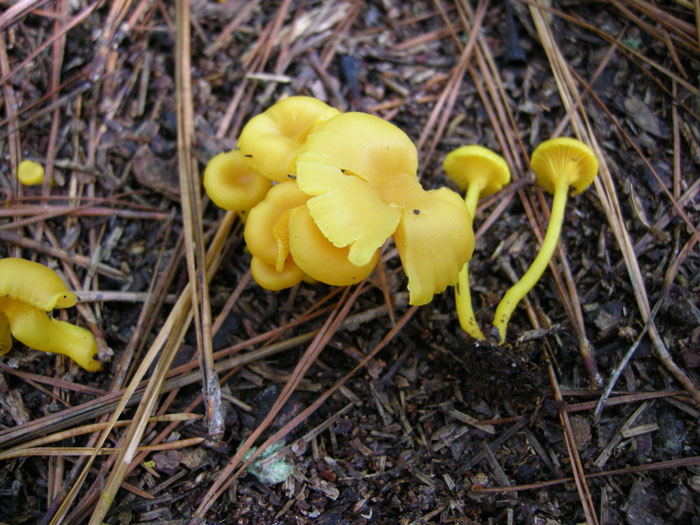Map Snapshot



2 Records
Description
Note bright yellow, deeply infundibuliform shape of the pileus and decurrent gills. Nitida means glossy. (L. Biechele, pers. comm.)
Seasonality Snapshot
Source: Wikipedia
| Gloioxanthomyces nitidus | |
|---|---|

| |
| Gloioxanthomyces nitidus | |
| Scientific classification | |
| Domain: | Eukaryota |
| Kingdom: | Fungi |
| Division: | Basidiomycota |
| Class: | Agaricomycetes |
| Order: | Agaricales |
| Family: | Hygrophoraceae |
| Genus: | Gloioxanthomyces |
| Species: | G. nitidus
|
| Binomial name | |
| Gloioxanthomyces nitidus (Berk. & M.A.Curtis) Lodge, Vizzini, Ercole & Boertm. (2013)
| |
| Synonyms[1] | |
| |
Gloioxanthomyces nitidus, commonly known as the shining waxcap,[2] is a species of fungus in the family Hygrophoraceae.
Taxonomy
[edit]It was originally described by Miles Berkeley and Moses Ashley Curtis in 1853 as a species of Hygrophorus. The specific epithet nitidus means "shining".[2] It was one of two species transferred to the newly created genus Gloioxanthomyces in 2013.[3]
Description
[edit]The fruitbodies have convex, apricot-yellow to orange caps that are 1–4 cm (1⁄2–1+1⁄2 in) in diameter. The pale yellow, waxy gills are decurrent, with a somewhat distant spacing. Other than the gills and the base of the stipe, the bright coloring of the fruitbody fades with age.[2] The spores are elliptical, smooth, and measure 6.5–9 by 4–6 μm.[4]
Distribution and habitat
[edit]It is found in North America, where it grows on the ground (often among mosses) in groups in coniferous or mixed forests.[4] It prefers bogs, swamps, and similar moist habitats.[2]
References
[edit]- ^ "GSD Species Synonymy: Gloioxanthomyces nitidus (Berk. & M.A. Curtis) Lodge, Vizzini, Ercole & Boertm". Species Fungorum. CAB International. Retrieved 2015-10-24.
- ^ a b c d Roberts P, Evans S. (2011). The Book of Fungi. Chicago, Illinois: University of Chicago Press. p. 158. ISBN 978-0-226-72117-0.
- ^ Lodge DJ; et al. (2014). "Molecular phylogeny, morphology, pigment chemistry and ecology in Hygrophoraceae (Agaricales)" (PDF). Fungal Diversity. 64 (1): 1–99. doi:10.1007/s13225-013-0259-0. S2CID 220615978.

- ^ a b Miller OK, Miller H. (2006). North American Mushrooms: A Field Guide to Edible and Inedible Fungi. Falcon Guide. p. 64. ISBN 978-0-7627-3109-1.
External links
[edit]
